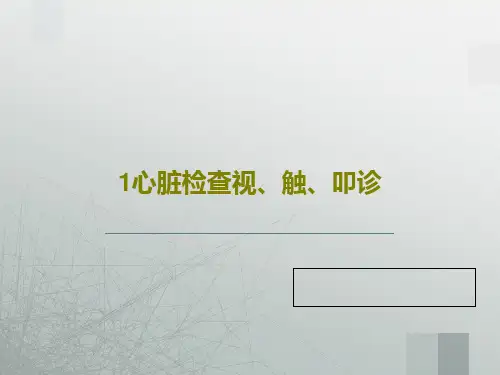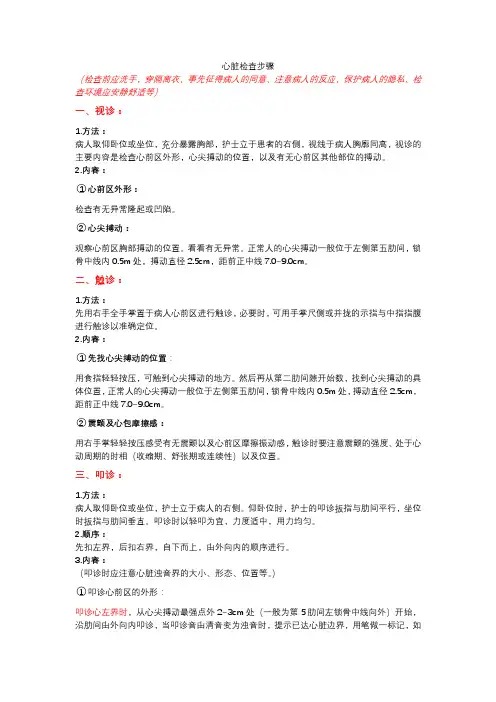心脏视触叩诊
- 格式:ppt
- 大小:2.04 MB
- 文档页数:38








心脏视触叩听病历书写范文英文回答:Heart auscultation is an important skill in medical practice, as it helps in assessing the condition of the heart and detecting any abnormalities. In my experience, I have encountered various cases where heart sounds provided crucial information for diagnosis and treatment.For instance, I once had a patient who complained of chest pain and shortness of breath. Upon auscultation, I noticed a high-pitched, blowing sound during systole, which is known as a heart murmur. This finding led me to suspect aortic stenosis, a condition where the aortic valve narrows and obstructs blood flow. Further investigations confirmed my suspicion, and the patient underwent successful valve replacement surgery.Another interesting case involved a patient with a history of heart failure. During auscultation, I detectedcrackling sounds known as rales, which are indicative of fluid accumulation in the lungs. This finding prompted me to adjust the patient's medication and closely monitortheir fluid intake. With appropriate management, thepatient's symptoms improved, and they were able to maintain a stable condition.In addition to auscultation, palpation and percussion are also important techniques in assessing the heart. For example, during palpation, I can feel for abnormal pulsations or thrills, which may indicate an enlarged heart or abnormal blood flow. Similarly, percussion can help determine the size and borders of the heart.Overall, heart auscultation, along with other examination techniques, plays a vital role in diagnosing and managing cardiac conditions. It requires a combination of knowledge, skill, and experience to accurately interpret the sounds and make appropriate clinical decisions.中文回答:心脏听诊是医学实践中的重要技能,它有助于评估心脏状况并检测任何异常。

心脏检查步骤(检查前应洗手,穿隔离衣、事先征得病人的同意、注意病人的反应、保护病人的隐私、检查环境应安静舒适等)一、视诊:1.方法:病人取仰卧位或坐位,充分暴露胸部,护士立于患者的右侧,视线于病人胸廓同高,视诊的主要内容是检查心前区外形,心尖搏动的位置,以及有无心前区其他部位的搏动。
2.内容:○1心前区外形:检查有无异常隆起或凹陷。
○2心尖搏动:观察心前区胸部搏动的位置。
看看有无异常。
正常人的心尖搏动一般位于左侧第五肋间,锁骨中线内0.5m处,搏动直径2.5cm,距前正中线7.0~9.0cm。
二、触诊:1.方法:先用右手全手掌置于病人心前区进行触诊,必要时,可用手掌尺侧或并拢的示指与中指指腹进行触诊以准确定位。
2.内容:○1先找心尖搏动的位置:用食指轻轻按压,可触到心尖搏动的地方。
然后再从第二肋间隙开始数,找到心尖搏动的具体位置,正常人的心尖搏动一般位于左侧第五肋间,锁骨中线内0.5m处,搏动直径2.5cm,距前正中线7.0~9.0cm。
○2震颤及心包摩擦感:用右手掌轻轻按压感受有无震颤以及心前区摩擦振动感,触诊时要注意震颤的强度、处于心动周期的时相(收缩期、舒张期或连续性)以及位置。
三、叩诊:1.方法:病人取仰卧位或坐位,护士立于病人的右侧。
仰卧位时,护士的叩诊扳指与肋间平行,坐位时扳指与肋间垂直。
叩诊时以轻叩为宜,力度适中,用力均匀。
2.顺序:先扣左界,后扣右界,自下而上,由外向内的顺序进行。
3.内容:(叩诊时应注意心脏浊音界的大小、形态、位置等。
)○1叩诊心前区的外形:叩诊心左界时,从心尖搏动最强点外2~3cm处(一般为第5肋间左锁骨中线向外)开始,沿肋间由外向内叩诊,当叩诊音由清音变为浊音时,提示已达心脏边界,用笔做一标记,如此逐一肋间向上叩诊,直至第二肋间。
叩诊心右界时,先沿右锁骨中线自上而下叩出肝上界,然后在其上一肋间(通常为第4肋间)开始,由外向内叩出浊音界,做一标记,在逐一肋间向上叩至第2肋间。